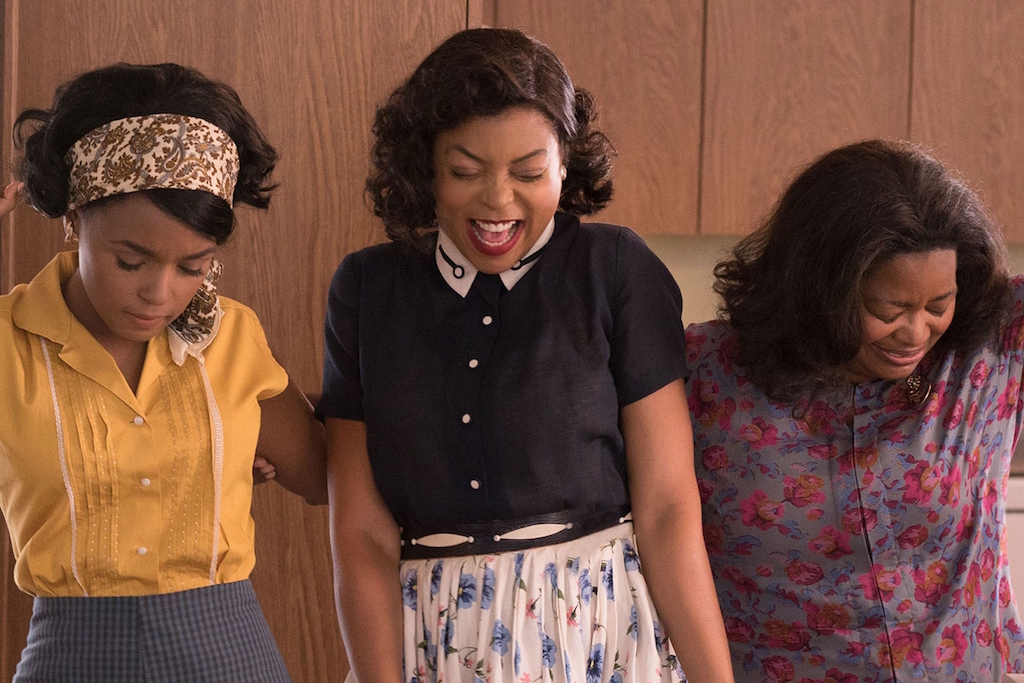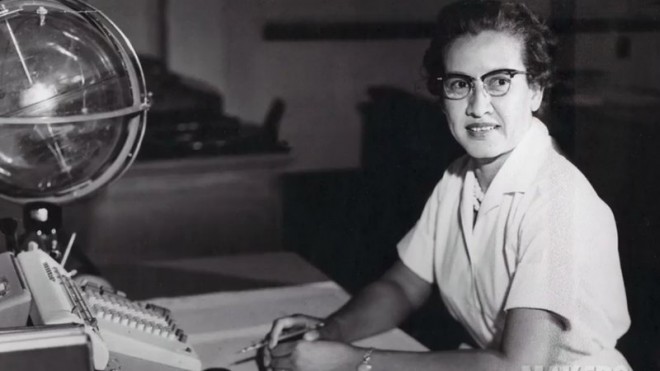‘Hidden Figures’ Is Revolutionary, Even If It Doesn’t Always Feel Like It
The film's success is from these three women (not the white dudes around them).

For decades, feel-good cinema has been used as an antidote for the darkest of times: stories of people prevailing over turmoil so we can remember the importance of being both tough and tender in the face of hardship.
The earliest memories of this for me were watching Mara Wilson’s Matilda using her genius to triumph over manipulative adults in Matilda (1996), and seeing Jess (Parminder Nagra) rebel against her Sikh family’s traditionalism to play for the women’s football overseas in Bend It Like Beckham (2002). The latter made me feel like I could choose any career path I wanted.
Taking us back to the US Civil Rights Movement of the 1960s, Hidden Figures shows audiences how African American people were treated as second-class citizens, and black women in particular — even those who were college-educated — got railroaded out of parts of the workforce. The film has a singular moment of white-hot rage: a searing monologue from NASA mathematician Katherine Johnson (Taraji P. Henson). It lands on her white, male co-workers like a tonne of bricks. But most of the racial and gender-based tension throughout is otherwise channelled into quick-witted dialogue and even-tempered truths.
The cynic in me wonders if this is the result of pressure to make the film seem more ‘pleasant’ and ‘acceptable’ to a wider audience. It’s definitely hitting the mark; Hidden Figures has soared to the top of the US and Australian box office. With a ‘60s Kodachrome look — lovely, bright colours and sharp, clean detail — the film is warm on the surface but somewhat jarring against the sinister, ever-present effects of the Jim Crow laws.
In 2017, this story feels timely. Many young women (especially those from an immigrant or low socio-economic background) still face obstacles when deciding on a career path where the precedent for success looks like a question mark. With programs like BEAM6 in the US and CHOOSEMATHS here in Australia, systemic change seems possible. But what role does Hollywood play in this kind of empowerment?
“Civil Rights Ain’t Always Civil”: Who Gets To Feel Empowered Here?
Hidden Figures is set over the course of a year in Hampton, Virginia, from 1961–2. It follows the race between the US and Russia to send the first human to outer space. Though it’s more accurate to say it follows the story of Dorothy Vaughan (Octavia Spencer), Katherine Johnson (Taraji P. Henson) and Mary Jackson (Janelle Monáe) — three incredibly talented (and marvellously cast) NASA employees. They’re all determined to overcome the era’s constraints of racial discrimination and change the course of history.
One of the best things about this film is that each woman has her own fully-formed story arc — they’re chasing their own dreams while also supporting those of their friends.
Katherine Johnson has to match the speed of her pencil to her mind when she gets reassigned to double-check the coordinates for the Friendship 7 spacecraft mission at the Space Task Group. Surrounded by a sea of white male co-workers who refuse to share even a coffee pot with her, she gets straight to work and eventually wins the respect of her ‘heart’s-in-the-right-place’ boss Al Harrison (Kevin Costner) and overcomes the indignant prejudice of her co-worker Paul Stafford (Big Bang Theory’s Jim Parsons).
Mary Jackson, on the other hand, wants to be NASA’s first black female engineer. Early on in the film, she insists that she doesn’t want to “entertain the impossible” however, after being told that she can’t legally attend classes at a non-segregated school to fulfil the requirements for the job, she sets her mind to how she can create a path for equal opportunity.
Dorothy Vaughan is also striving for bigger opportunities at NASA and takes it upon herself to learn the mysteries of a groundbreaking new computer to guarantee her continued employment. Despite being routinely undermined by her boss, Vivian Michael (an icy Kirsten Dunst), Vaughan doesn’t just use her knowledge to advance her own skills, but eventually brings in a team of women from the West Computing Group with her.
It’s inspiring to watch other women being good at their job. Even more so, considering these scenes of complex mathematical problem-solving are nearly ways reserved for white men. True to its name, Hidden Figures brings brilliant women of colour to the forefront, and it’s even more uplifting to know this isn’t pure fiction. These characters are based on real women and their accomplishments.

The real Katherine Johnson. She’s now 98 years old.
I had some initial uneasiness about how this kind of script could fall into a white saviour narrative — particularly with Kevin Costner’s character who performs a few well-meaning (if sometimes over-the-top) acts of trying to install parity at NASA. But I think this is ultimately a film about how these women constantly showed up and got the job done (even if they weren’t always thanked for it), more than it is about men or women who eventually give them permission to do the work.
Taraji P. Henson as Katherine Johnson grows more and more confident in each scene. Her gentle no-problem-sir demeanour melts away into pure passion. Spurred on by sincere diligence and the need to get into the daily briefings to do her job, at one point tells Al Harrison without hesitation “You’re the boss. You just have to act like one. Sir.”
For Mary Jackson (Monáe), tactfully employing diplomacy serves her well. After being granted legal permission to attend “only” the night classes to become an engineer, she lets her calm courtroom demeanour fade away, yelling in triumphant joy down the street.
It’s bittersweet to watch her pull off this major coup. I resented the white male judge for needing to be ‘convinced’ to let a capable woman achieve her career goals. But ultimately, it’s her win. Like her best girlfriends at NASA, she successfully flipped the system.
#HiddenNoMore
Though the film is defined by the expertise of black women (both on- and off-screen), it’s worth noting that writer-director Theodore Melfi and his co-writer Allison Schroeder are both white. Also, while the picture is meticulously realised with visual as well as narrative skill, it does leave out or reduce many of the details in Margot Lee Shetterly’s book of the same name.
These deviations are partly because the film is based on a 55-page proposal for the book, not the final manuscript. Both Kevin Costner and Kirsten Dunst’s characters, for example, are composites of different people who represented conflicting attitudes of the time. Due to refusal of rights to depict the specific individuals, this was the director’s solution. Jim Parson’s character is also a fictional representation to demonstrate how someone with racist and sexist attitudes of the era could have a genuine change of heart.
The real Katherine Johnson has reportedly seen, and approves of, the film. But like The New Yorker’s Richard Brody, I found myself wondering what kind of film this would’ve been if someone like filmmaker, writer and civil rights activist Kathleen Collins had had the opportunity to pen the script, or how its cinematic vision would’ve been realised if Ava DuVernay or Spike Lee or Julie Dash had been behind the camera.
The film features real archival footage of the events leading up to the space race, which adds an element of historical authority. I only wish there had been more opportunity — or time — to feature more political footage of the era. Hidden Figures closes on an optimistic note as ‘I See a Victory’ by gospel singer Kim Burrell and Pharrell Williams sounds out over the speakers and previously unseen archival photographs of the three women appear on screen.
It’s clear that the film is a success by any metric. It’s outperforming La La Land at the box office and close to surpassing Sister Act (1992) as the highest-grossing film ever to be fronted by African American women. It’s nominated for three Oscars. It’s also playing in cinemas during both Black History and Women’s History months, raising the profiles of three powerful women with the hope of inspiring countless more.
One of the marks of empowerment cinema like this is being able to look back on history and say ‘look how far we’ve come’. It’s satisfying in theory and certainly applicable to how Hidden Figures wrapped up but, for me, the film also came with a reality check: ‘look how far we still have to go’.
I walked out of the cinema, wanting badly to see change for women who still struggle to assert their career paths and dreams. This is change I want to be able to see in my lifetime; to not just get burnt out or become exhausted over time spent constantly demanding it. Now, visible in plain sight, it’s time to look around and recognise whose experiences we need to make known and commit them to memory.
–
Hidden Figures is in cinemas now. Free screenings will take place in selected states across Australia.
–
Nathania Gilson is a Melbourne-based writer and video editor.